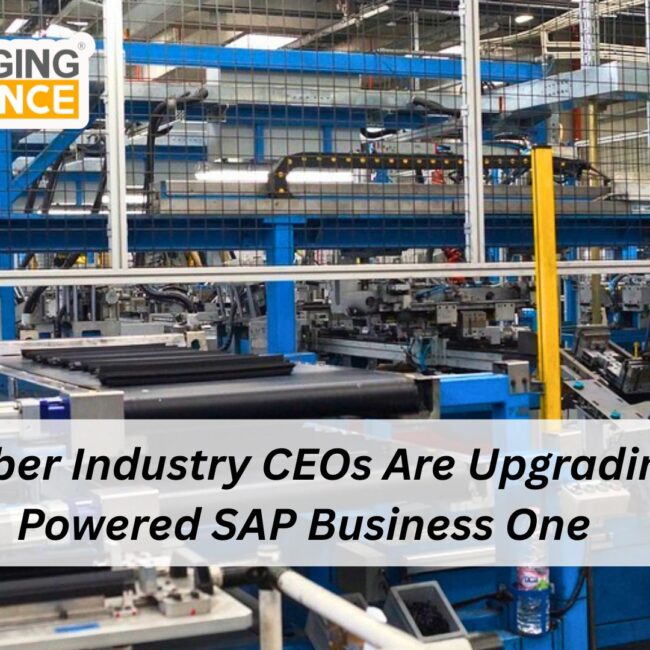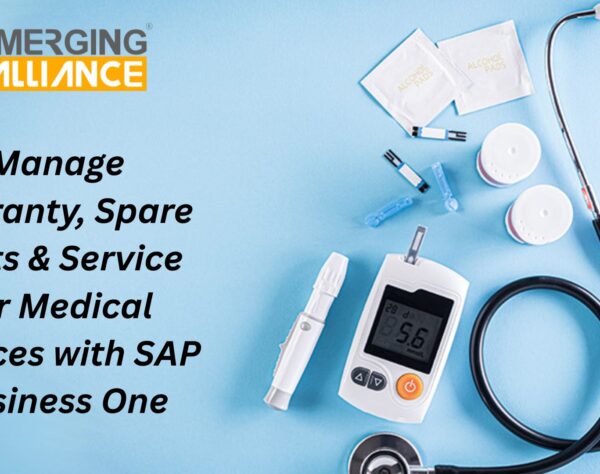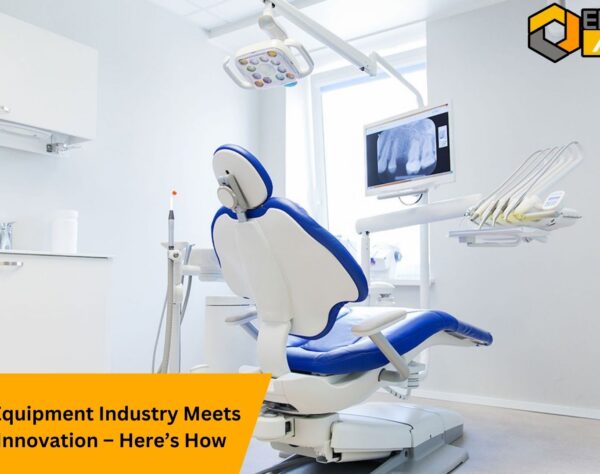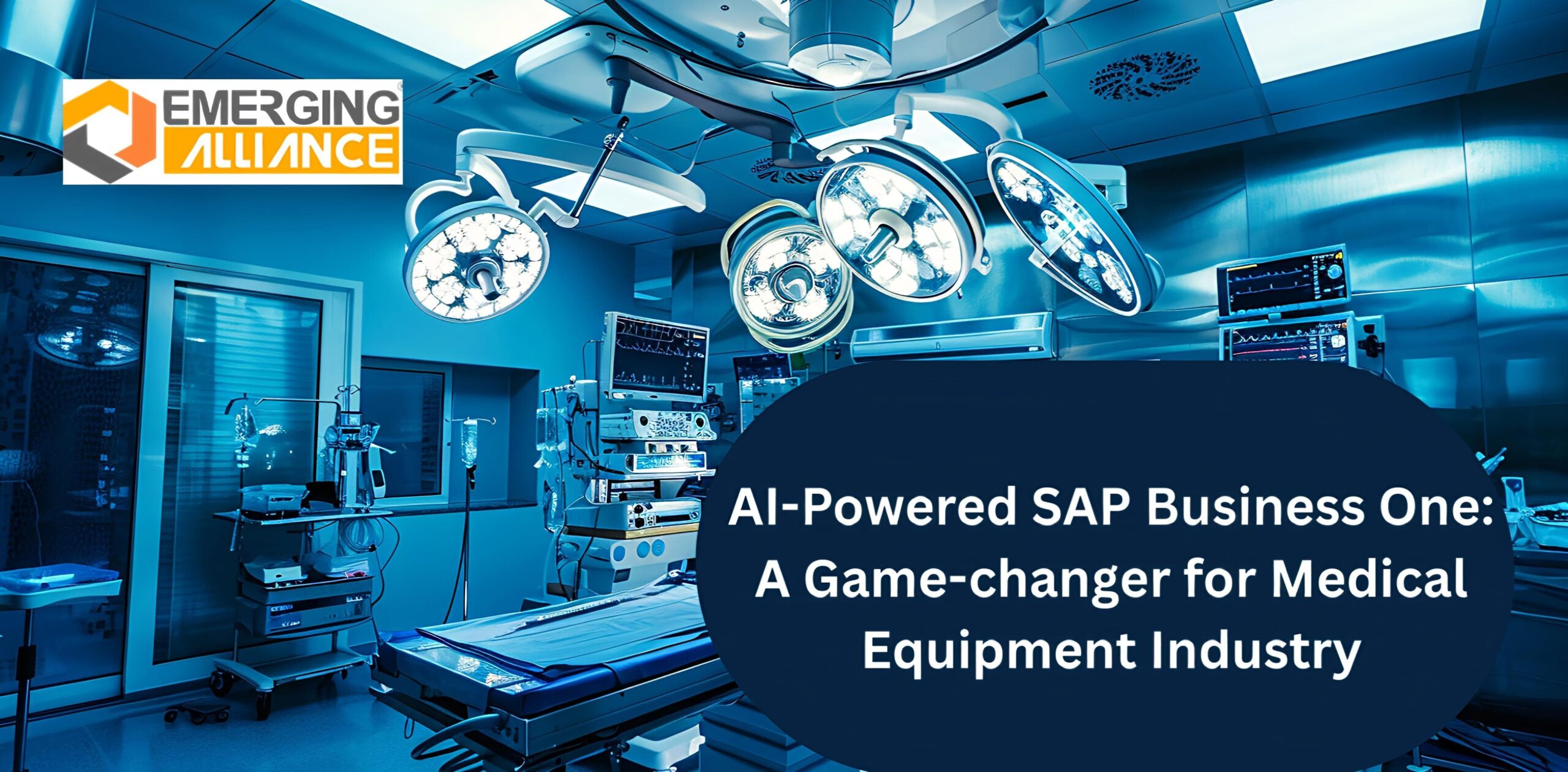
SAP B1 with AI: A Game-Changer for Medical Equipment Industry
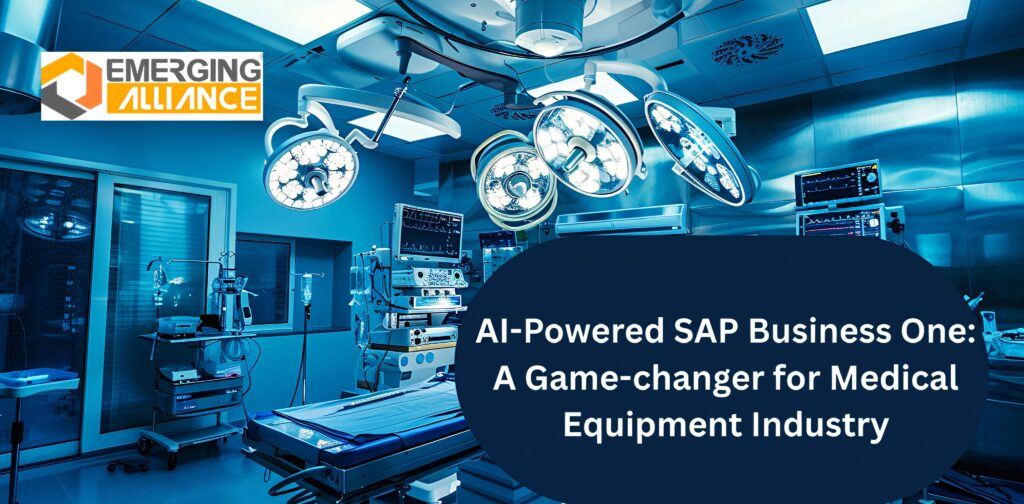
The Role of SAP B1 in Revolutionizing Medical Equipment manufacturing
In the fast-evolving medical equipment industry, CEOs are under pressure to balance quality, compliance, and scalability. Many are now replacing outdated legacy systems with AI-enabled SAP Business One (SAP B1) — a smart ERP built to handle everything from FDA compliance to real-time equipment tracking. With rising global regulatory demands and increasing market competition, intelligent ERP isn’t a luxury — it’s a necessity. Here’s why MedTech leaders are making the switch and how it’s helping them achieve operational excellence.
Key Challenges faced by the CEOs of Medical Equipment manufacturing industry and SAP Business One as its one-stop solution
🧯 1. Challenge: Legacy Systems Can’t Keep Up with Regulatory Compliance
Manual systems and outdated ERPs often fail to meet the rigorous documentation and traceability demands of FDA, MDR, and UDI guidelines. MedTech CEOs are constantly under pressure to ensure inspection readiness with zero tolerance for error.
✅ How SAP Business One with AI Helps:
AI-enabled SAP Business One automates version control, audit trails, document expiry alerts, and compliance workflows — all aligned with international medical device regulations.
Real-Life Result:
A Class II device manufacturer in Pune reported a 50% reduction in audit preparation time after automating MDR documentation using SAP B1.
📊 2. Fragmented Quality Data Slows Decision-Making
Legacy systems scatter quality data across spreadsheets and disconnected tools. This makes non-conformance tracking, trend analysis, and root cause detection nearly impossible in real time.
✅ How SAP B1 with AI Helps:
It unifies QA/QC with automated quality alerts, visual dashboards, and trend predictions — helping CEOs and quality managers react before defects turn into recalls.
Use Case:
A surgical instruments firm saw a 35% drop-in rejection rate after implementing predictive quality analytics using SAP B1’s AI modules.
⏱️ 3. Real-Time Visibility: The CEO’s New Competitive Advantage
Legacy ERPs provide monthly reports. By then, it’s too late to pivot. MedTech CEOs need live data on production, compliance flags, and cost centers to make quick, confident decisions.
✅ How SAP B1 with AI Helps:
Built-in AI dashboards offer real-time visibility across all departments. Whether it’s production efficiency, QA deviations, or inventory turnover — CEOs stay in control, anytime, anywhere.
🔁 4. Manual QA Workflows = Delays + Risk
Manual quality assurance processes delay product release, increase the chance of non-compliance, and slow batch approvals. It’s not scalable for growing MedTech firms.
✅ How SAP B1 with AI Helps:
Automates inspections, triggers alerts on non-conformance, integrates with LIMS, and logs QA data in real-time.
Result:
A MedTech exporter cut batch approval time by 40% with SAP B1 AI-powered QA workflows and automated documentation trails.
🚚 5. Predictive Maintenance & AMC Automation Simplified
Legacy systems track maintenance manually, risking unplanned breakdowns and dissatisfied customers. For CEOs, this translates into service inefficiencies and brand damage.
✅ How SAP B1 with AI Helps:
AI predicts service needs, automates AMC scheduling, and connects field service data with ERP records — ensuring maximum uptime and customer trust.
💡 6. From Gutfeel to Data-Driven: AI Dashboards That Drive Growth
CEOs using legacy systems often rely on gut instincts for pricing, planning, and investments due to lack of real-time insights.
✅ How SAP B1 with AI Helps:
Interactive dashboards surface real-time trends in margin performance, order cycles, compliance risk, and cost leaks — empowering smarter, faster decision-making at the top level.
Insight:
A diagnostics device company scaled to 3 new markets within 12 months, attributing its success to real-time cost control and forecasting dashboards in SAP B1.
⚙️ The Medical Equipment Industry ERP Shift: From Manual Chaos to Smart Control
Legacy systems often rely on disconnected spreadsheets, email chains, and manual processes. This leads to data duplication, audit risks, and long delays in device launches. SAP B1, enhanced with AI, brings all departments onto a single platform — integrating quality control, regulatory documentation, production planning, and inventory.
Real Example:
A Chennai-based surgical equipment manufacturer reduced their MDR reporting time by 40% using AI-enabled SAP B1 modules that automate regulatory workflows and batch traceability.
❓ Why Are Legacy Systems No Longer Enough in Medical Equipment Manufacturing?
Legacy ERPs lack device-specific workflows, audit trails, and real-time insights. CEOs today need predictive analytics, regulatory automation, and AI-powered compliance triggers — features legacy tools simply don’t offer.
Data Insight:
A recent Gartner study found that 64% of MedTech companies plan to upgrade their ERP within 2 years, with “compliance automation” and “AI-readiness” being the top two drivers.
🔍 How Does AI in SAP Business One Give CEOs a Competitive Advantage?
AI tools built into SAP B1 allow CEOs to:
1. Forecast demand using historical sales and real-time usage patterns.
2. Receive alerts for quality deviations before failures occur.
3. Automate AMC and service schedules to reduce downtime.
4. Gain real-time visibility across production, compliance, and financial metrics.
Use Case:
A diagnostics device firm in Pune cut QA cycle time by 35% and achieved 100% traceability using AI-powered dashboards that connect factory floor data with executive-level KPIs.
📊 Smart Compliance Built In — Not Bolted On
MedTech companies must meet strict guidelines like FDA 21 CFR Part 11, MDR, and UDI. AI-enabled SAP B1 includes built-in compliance templates and automated document version control — helping teams stay inspection-ready at all times.
📈 Real-Time Dashboards for CEO-Level Decision Making
Modern MedTech CEOs can’t wait for monthly reports. SAP B1 with AI delivers live dashboards showing performance metrics, compliance flags, and financials — accessible anytime, anywhere.
🧩Before vs. After – The MedTech ERP Evolution
| Feature | Legacy Systems | AI-Enabled SAP B1 |
|---|---|---|
| Regulatory Compliance | Manual paperwork, error-prone | Automated, audit-ready, AI-powered |
| Device Traceability | Spreadsheet-based tracking | Real-time lot & serial traceability |
| Quality Management | Reactive inspections | Predictive QA with real-time alerts |
| Decision Making | Delayed, manual reporting | Live dashboards with AI insights |
| Maintenance & Service | Reactive AMC | Predictive service scheduling via AI |
| Go-To-Market Speed | Delays due to disconnected systems | Faster launches with unified ERP + AI |
Final Thoughts
AI-powered ERP like SAP Business One is revolutionizing the medical equipment industry by delivering real-time visibility, predictive analytics, and regulatory compliance in one integrated platform. As the industry faces increasing demands for quality, traceability, and faster innovation cycles, MedTech CEOs are rapidly moving away from legacy systems that lack flexibility and insight. Instead, they’re embracing intelligent ERP solutions to future-proof operations, enhance decision-making, and stay competitive in a highly regulated and fast-evolving market. The shift reflects a broader mindset change—from viewing ERP as a back-end tool to leveraging it as a strategic driver for innovation and growth.
FAQs
1. What is AI-enabled SAP Business One for medical equipment manufacturers?
AI-enabled SAP Business One helps medical equipment manufacturers streamline operations, ensure compliance, and make smarter decisions with real-time insights.
2. Why are medical device companies switching from legacy systems to SAP B1?
Because legacy systems can’t handle modern needs like FDA/MDR compliance, AI forecasting, or real-time QA.
3. How does AI improve SAP Business One for MedTech?
It adds predictive maintenance, automated alerts, smart dashboards, and real-time insights.
4. Is SAP B1 compliant with medical device regulations like MDR or FDA?
Yes, it includes built-in tools for UDI, batch tracking, document control, and audit readiness.
5. Can SAP B1 handle QA/QC automation in medical device manufacturing?
Absolutely. AI enhances QA modules to monitor, alert, and automate non-conformance actions.
6. What kind of reports can CEOs get from AI-enabled SAP B1?
Live dashboards for inventory, quality, finance, compliance, and production KPIs.
7. How long does it take to implement SAP B1 in a MedTech company?
On average, 4–12 weeks depending on customization and company size.
8. Can SAP B1 integrate with lab and testing equipment?
Yes, it supports LIMS and other third-party integrations for seamless QA data flow.
9. Does SAP B1 help with preventive maintenance for equipment?
Yes, AI modules can trigger alerts before failures, schedule service, and manage AMC.
10. How can I choose the right SAP B1 partner for my medical equipment business?
Look for domain-specific experience, AI readiness, and proven MedTech implementations — like Emerging Alliance.
💡 Ready to transform your medical equipment business with SAP Business One? Contact us today!
Also read, similar articles that interests you on SAP Business One for Medical Equipment Industry.


